Direct
Intaglio-Type
Use of actual
object for block out in the exposure unit, and work directly on
ImagOn's protective mylar.
Materials:
- Plate laminated with ImagOn
I
YC aquatint exposure:
16 L.U
LaCour aquatint exposure:
12 L.U.
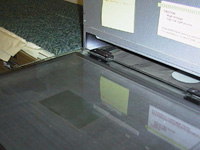
|
Method One:
For imagery to be created on ImagOn's protective
mylar surface.
- Expose to Aquatint Screen. with the top Mylar
protection sheet in place
- The Aquatint exposure remains constant for each exposure
unit. The aquatint screen simulates the results of conventional
etching aquatints by exposing a densely clustered random dot onto the
ImagOn coated plate.
- Create image on the surface of the protective mylar
- Image Exposure: Dependent on the image. Since the image is one the
mylar surface, the use of the vacuum frame is not necessary.
- Varied Exposure time varies according to
imagery. Generally they are a bit less than exposure of
wash/drawing technique.
|
! Caution !
The greatest difficulty with Method One is the difficulty in knowing the
exposure.
|
Image Making
Techniques
Materials that work well on the Mylar surface:
- Toner Tusche
gets great reticulation
on the smooth surface
- Card Notched
- Spray with windex, Fantastik or water
into the wet toner for some interesting effects
- Draw
- Micron Pigment Liner
- Staetler Pigment Liner
- Litho crayons 00-3 and litho pencils
- Oil sticks
- India Ink and drafting ink (on less
sensitive exposure systems, the india ink did not work very well.
- Stamping Techniques
- Scratch through Black area
Paint with diluted Graphic Chemical
water soluble relief ink. If the ink is applied too thickly it will
cause the ImagOn emulsion to be removed when the Mylar is stripped from
the ImagOn plate.
|
|
.
|
Materials that work with the Mylar surface removed
after aquatint exposure:
- all kinds of water soluble inks and watercolors can be applied
directly to the unprotected ImagOn emulsion. Because the original wash
painting will be dissolved during the developing of the plate your
print yield will be limited to the number of prints that can be pulled
from this plate. There is no ability to re-expose.
|
|
|
Remove mylar
The wash painting on the surface of the Mylar, can be dried and re-used
at a later date. Re-using will necessitate a reversal of this image to
place the ink emulsion in direct contact with the ImagOn plate.
|
|

If objects are too thick or have sharp edges, the vacuum frame can be
ruined. Seek advice on use of the vacuum unit.
|
Method Two:
Shadowgram technique
For actual object used as imagery.
- Expose to Aquatint Screen with the top Mylar
protection sheet in place
The Aquatint exposure remains constant for each exposure
unit. The aquatint screen simulates the results of conventional
etching aquatints by exposing a densely clustered random dot onto the
ImagOn coated plate.
.
- Actual objects are placed on the surface of the plate. Weight
down the object with the vacuum frame, its top or heavy glass.
Objects placed on top of the vacuum frame and covered with a heavy sheet
of glass will be softer edged images due to the distance of the object
from the plate.
- Image Exposure: to the image. Since the image is one the
mylar surface, the use of the vacuum frame is not necessary.
Varied Exposure time varies according to
imagery. Leaves and feathers take more time than wash images.
|
|

If objects are too thick or have sharp edges, the vacuum frame can be
ruined. Seek advice on use of the vacuum unit.
|
Method Three:
Negative reading Images
For actual object used as imagery.
Expose Aquatint Screen and objects at the same time.
|
|
xx
|
xx
|

Rubber gloves RECOMMENDED for
the development procedure. Repeated use of developing solution can dry out
the skin and cause a dermatitis reaction on the hands.

Eye protection advised.
The developer is an alkaline solution. Do not
splash the developing solution into eyes.

Dry without heat
|
Develop
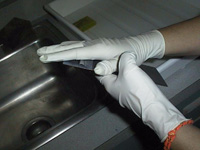 . . 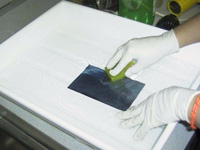 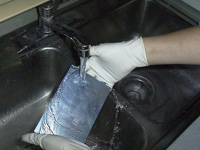 . . 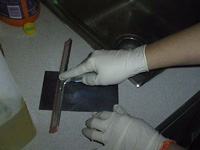
|
|
xx
|
xx
|
|
xx
|
xx
|


 .
. 
 .
. 